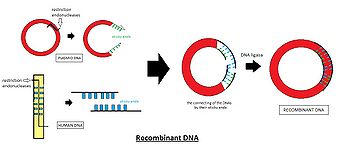Recombinant DNA
From WikiLectures
- Recombinant DNA is an artificially produced DNA.
- It is usually formed by more DNA sources from the different donor.
- The sticky ends can put together the individual strands of the DNA.
- The restriction endonucleases cut the DNA out and DNA ligase incorporates it.
- For the recombination we need many and many copies of the DNA. That is the reason for using the PCR – polymerase chain reaction.
- To incorporate the sample od the DNA into the host cell it is necessary to use the vector.
- After replication in the host cell – on the issue culture – we can work with the exact part of the DNA.
- The recombinant DNA is much used in the gene manipulation. Thanks to it we are able to produce some important human hormones and enzymes.
- The clones od the DNA samples can be also used for the forming of the gene maps.
The Process of the DNA Recombination[edit | edit source]
- to isolate the exact part of the DNA from the organism
- to put the DNA into the DNA vector (E.coli, bacteria, yeast)
- to transfer the vector by into the host
- to find out the compati sticky ends of two DNA strands
- to put it together by DNA ligase
- to clone the new DNA by PCR – polymerase chain reaction
- to get many copies of the recombinant DNA
Links[edit | edit source]
Related articles[edit | edit source]
Sources[edit | edit source]
Bibliography[edit | edit source]
- ALBERTS,, et al. Základy buněčné biologie. 2.vydání edition. 2007. ISBN 80-902906-2-0.
- MURRAY,, et al. Harperova biochemie. 4.vydání edition. 2002. ISBN 80-7319-013-3.

